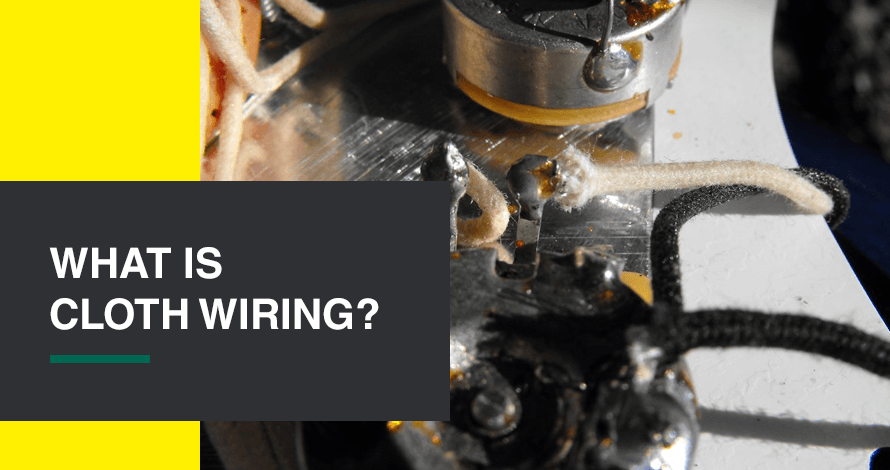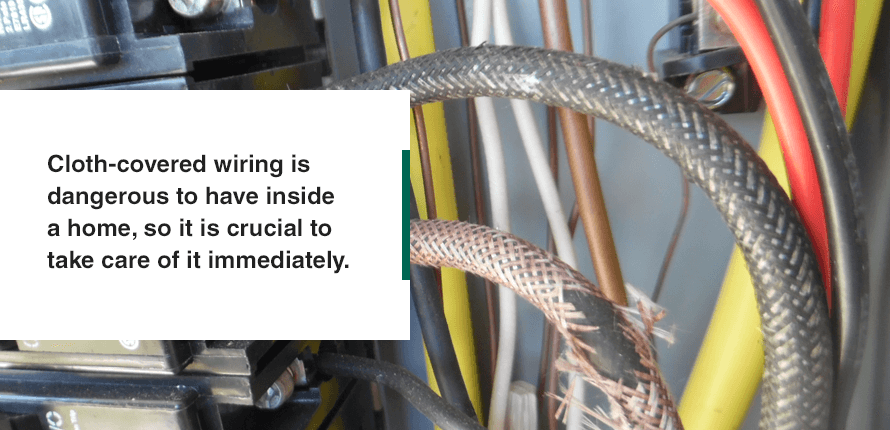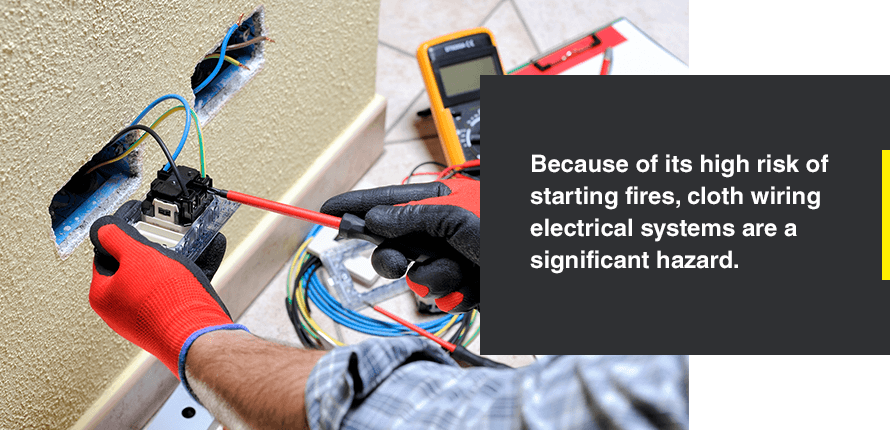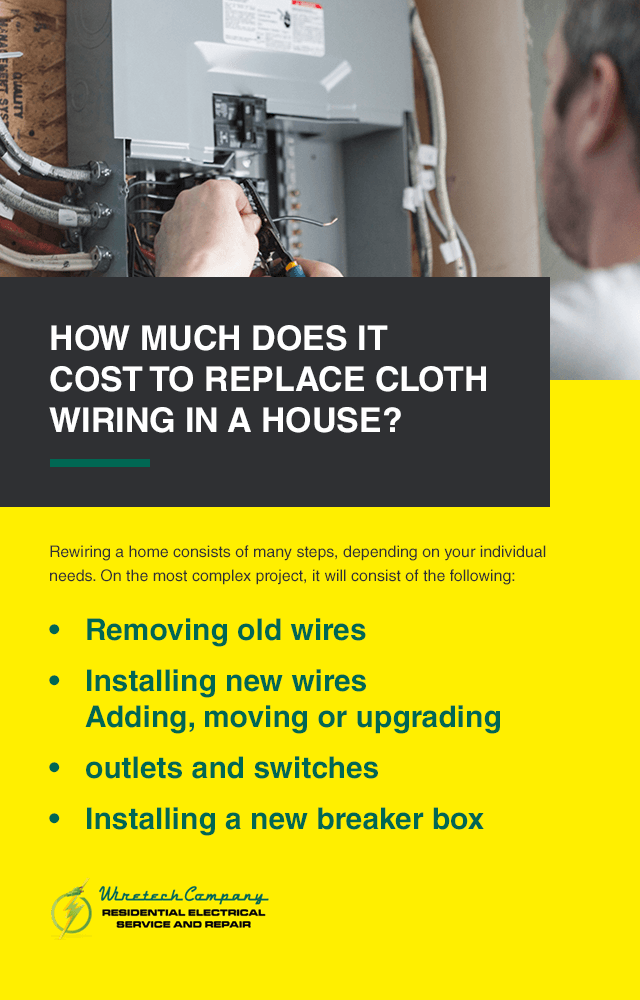
Builders relied on cloth wiring during the first half of the 20th century. If you own a home built before 1960, there’s an excellent chance it could have cloth wiring, which consists of inexpensive fabric coverings used to insulate and protect electrical conductors.
Outdated cloth wiring — often used in conjunction with ceramic knobs and tubes to run electrical wires throughout the walls — is a danger you can’t ignore if you find it in your home. Learn how to identify cloth wiring, what to do if you discover it and more.
What Does Cloth Wiring Look Like?
Owners of older homes may face some unique challenges, like learning how to spot outdated standards and bringing your structure up to code. In general, if your home is more than 60 years old, it could have cloth wiring inside. As a homeowner, one of the best things you can do is learn how to identify cloth wiring.
Some cloth wiring can be a bit misleading, appearing to have a fully rubberized covering, while there is most likely insulating cloth inside the outer coating. You can look for some details, like color, to help determine if your home houses cloth wiring. The exterior coatings most commonly used for cloth wiring insulation are black, silver and sometimes brown. If your home features knob-and-tube wiring, the chances that it also has cloth wiring are quite high.
In many cases, you can also inspect the wiring for the name of the manufacturing company that produced it. You can typically find these names stamped onto cloth wiring’s outside coating.
Here is a list of some of the most common cloth wiring manufacturers:
- Ammcoflex
- Cablex
- Chester-Flex/Silv-A-Flex
- Cirtex
- Cres-Flex
- Dutrax
- Essex
- Etcoflex/Ettcoflex
- Hatflex
- KFlex
- Narax
- Paraflex
- Phelps Dodge
- Roflex/Romex
- Southwire
- Triangle PWC
If you have visually inspected your wiring and are still unsure what kind you have, it is always best to consult with a professional. An experienced electrician can quickly identify any signs of cloth wiring in your house. A knowledgeable home inspector may also be able to recognize the characteristics of cloth wiring. No matter the professional you choose to bring in, be sure to address this outdated form of wiring as soon as possible.

Why Is Cloth Wiring Dangerous?
Cloth-covered wiring is dangerous to have inside a home, so it is crucial to take care of it immediately. The materials used to make cloth-covered wire tend to become highly brittle over time and can eventually lead the protective outside coating to flake and fall away. When this happens, it exposes the underlying wires, providing the perfect opportunity for electrical arcing to occur. This phenomenon is when electricity jumps from one wire to another, and it is a fire hazard.
Another issue with old cloth wiring is that it attracts more pest damage than modern wiring because the insulation is easy to chew. This damage also exposes electrical wires, which can ultimately lead to a fire.
A lot of cloth electrical wiring manufacturers used asbestos. Since it was a highly cost-effective and efficient form of insulation, it seemed like the ideal material at the time. However, asbestos carries many health risks to humans, as it is a carcinogen. Many kinds of cloth wiring feature copper covered in rayon or cotton wrapped in asbestos paper. As time passes, it becomes brittle, allowing the outer layer to break away and sending the asbestos into the air, causing a significant hazard for homeowners.
While the cloth-covered wire was sufficient for electrical conduction at the time, times have changed. Today, homeowners use a lot more power for their daily lives than back in the early 20th century. Where current electrical wiring can take the heat, older cloth wiring is not an effective insulator. Cloth wiring’s inability to hold up to excessive amounts of heat means that there is always a fire risk.
Grounding is an essential safety feature for any home because it directs any excess electrical current into the earth, preventing it from reentering the home’s electrical system. Grounding considerably reduces the risks of an electrical arc fire.
A grounded home will also have a circuit breaker instead of a fuse box, eliminating the risk of a power overload and reducing the risks of fire. Three-pronged and GFCI outlets are also a safety feature for many homes that cloth wiring does not allow.

When Did They Stop Using Cloth Wiring?
Builders relied on cloth wiring for homes built before the 1960s. However, most people were unaware of the inherent dangers. It posed a severe fire hazard for homes of all kinds due to its lack of grounding, in addition to many issues such as asbestos exposure. One of the wiring’s most concerning factors was its unpredictability and tendency to fail without warning.
Around the 1950s, PVC plastic began to replace rubber wire and fabric-based insulation. By the 1970s, builders widely used this plastic cable — also called Romex cable — to build homes. It eventually came to completely replace all cloth-covered wiring products.
Not only was cloth wiring an overall safety concern for homeowners and their families, but it also caught insurance companies’ attention because of its ability to cause extensive damage if overlooked.
Because of its high risk of starting fires, cloth wiring electrical systems are a significant hazard. Over time, homeowners with cloth wiring can accrue much higher insurance premiums than those with safer, modern wiring systems. The accumulated costs of insurance premiums can quickly add up to exceed the expense of updating and overhauling your home’s electrical system.
Insurance companies can refuse to insure your property if it has a cloth wiring system. Some home insurers may be willing to work with you depending on the wiring’s circumstances and condition. However, most companies are likely to require you to replace your outdated electrical wiring before authorizing any insurance coverage.
What to Do If You Have Cloth Wiring
If you suspect you have cloth wiring in your home, it is best to address it as soon as possible. The first step is to be sure your home has cloth wiring. Contact a professional, such as an electrician. Not only will they help you determine if your home has old cloth wiring, but they can also provide you with information regarding how much time and money it could cost to have it replaced. They can also fill you in on your wires’ current condition and identify any alarming safety hazards.
If you discover your home has cloth electrical wiring, the next best thing you can do is to have a test to detect hazardous asbestos. Asbestos testing and removal requires a specialized company to safely identify and remove the wiring from your home. Professionals can ensure no asbestos fibers get released into the air and impact the health of everyone in your home.
Many people ask, “Do I have to replace cloth wiring?” The answer is yes. Due to the many safety hazards cloth wiring creates, you should not gamble with leaving it inside your home.
In some rare cases, it is possible to have cloth wiring without the knob-and-tube wiring system. Depending on your overall power system’s condition, your electrician may feel comfortable enough to replace all the cloth wiring with the current, plastic-coated wires used today. If the knob-and-tube system is in good enough shape, this could also be an option. While knob-and-tube can still fail, it is not quite as dangerous as cloth wiring.
An experienced electrician might approve the more affordable option of replacing the wires if everything else is in good shape. However, remember that insurance companies have the right to refuse insurance to homeowners who have such outdated wiring systems.
Overall, replacing cloth wiring and knob-and-tube electrical systems is the best option, in the long run, to ensure safety and eliminate the dangers that come with them.

How Much Does It Cost to Replace Cloth Wiring in a House?
On average, the cost to update electrical wiring in a home depends on your home’s size, the project’s complexity and the costs of labor and materials.
Rewiring a home consists of many steps, depending on your individual needs. On the most complex project, it will consist of the following:
- Removing old wires
- Installing new wires
- Adding, moving or upgrading outlets and switches
- Installing a new breaker box
Electricians may charge by the hour for their work, plus per square foot of wiring. If your home needs an updated electrical panel, the price range depends on amperage. A complete panel system requires a new meter, service drop, panel wiring, piping and weatherhead. All these expenses will be in addition to any hourly or per-square-foot rates your electrician requires.
If your home is considerably older, your chances of needing a total replacement are high. It is critical to remember this when factoring in even the most minor details required, such as outlets and switches, to bring your home’s entire electrical system up to date. The types of rooms you need to have rewired can also make a difference in cost. Kitchens and bathrooms typically cost more than bedrooms due to the need for heavy-duty materials for safety.
If your electrician must open your walls to perform the rewiring, repairing the damage after completion can add to the project’s total cost per square foot. Eventually, the cost of opening and closing walls during a rewiring project can make up a significant percentage of your rewiring budget.
How long will it take for an electrician to rewire your home? It varies depending on your property’s size and age, plus how complex the project will be. You can ask your professional for a time estimate before agreeing to any work.
Some homeowners can move from room to room while the electrician completes their work. However, depending on the extent of the project, you may wish to stay with a friend or family member while your home is under construction, especially if the electrician needs to remove and replace walls.
While it may be expensive, rewiring your home is a one-time cost that is worth the investment, especially in terms of safety. When choosing an electrician to complete the job, ensure they are fully licensed, insured and experienced with rewiring homes.

Contact Wiretech for a Comprehensive Home Electrical Inspection in Raleigh
If you believe your home may have cloth wiring, Wiretech is here to help. We pride ourselves on being the best choice for managing electrical inspections, repairs and upgrades. We offer thorough safety inspections to help identify any potential hazards in your electrical system. Our experienced and licensed electricians will:
- Identify existing problems.
- Recommend solutions for home safety.
- Ensure your entire electrical system is operating correctly.
- Help meet insurance risk inspection requirements.
- Assess an electrical system before a potential home purchase.
- Help you reduce energy usage and costs.
At Wiretech, we treat our customers with nothing but respect and provide excellent customer service. Our entire team — from the ones who take your phone calls to the technicians who visit your home — will be more than happy to address any questions or concerns you may have regarding your electrical system. Contact us at Wiretech today to see how we can assist you.
